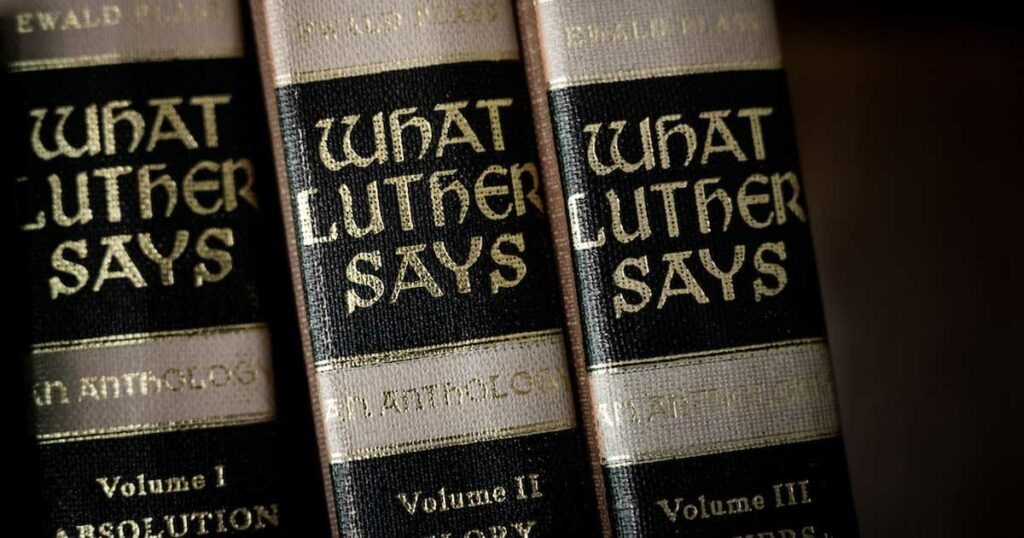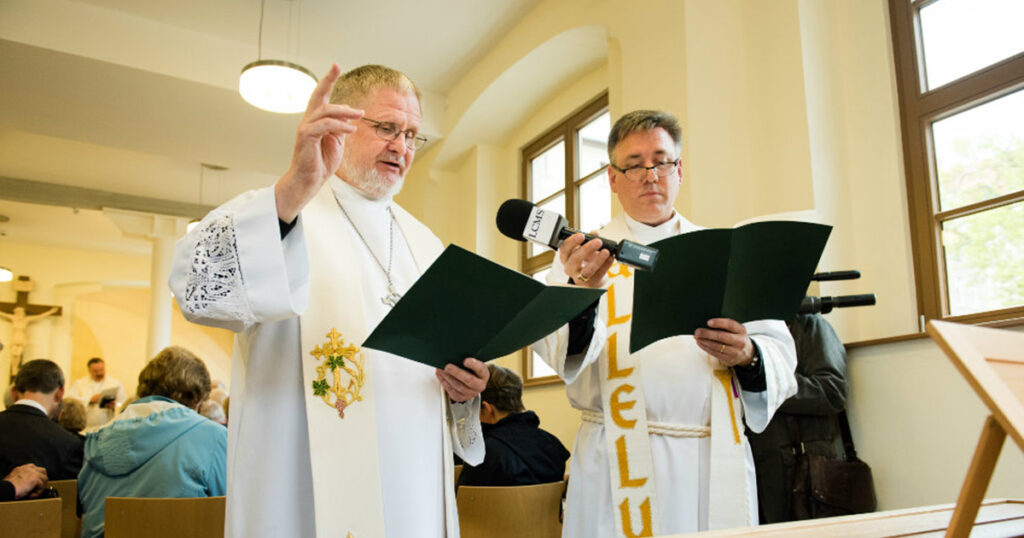The past five years have given Christians around the world opportunities to mark the 500th anniversaries of a series of significant events in the development of the reform movement launched in 1517 when Martin Luther posted his Ninety-five Theses on indulgences. In 2022 the church will mark the 500th anniversary of the publication of Luther’s translation from the Greek of the New Testament, his September Testament, the first widely distributed translation of Scripture in a vernacular language in the modern era. This anniversary will give rise to a wide array of celebrations among students of German language and literature and scholars in the field of media and communications. This anniversary will also encourage Bible study in the vernacular languages among people on every continent.
Largely unnoticed, however, was the anniversary of the publication in January 1522 of the last of six programmatic treatises on what Luther’s reform concept entailed. These six treatises clearly set forth Luther’s maturing vision of a church recalled to the Gospel of Christ as its center.
Six treatises
These six treatises deconstructed medieval teaching and piety and reconstructed both the doctrine of the church and the practice of the faith at the parish level. In June 1520, at the insistence of his friend Georg Spalatin, personal secretary to Elector Frederick the Wise, Luther defended himself against charges that his proclamation of salvation by faith alone undermined morality and the social order. He composed On Good Works, a commentary on the Ten Commandments that described the life of faith (LW 44:21–114). He argued that those who truly believe that God’s pronouncement of forgiveness of sins renders them righteous children of God hearken to his commands. The reality of this faith shows itself in the life of obedience that carries out God’s will as expressed in the Decalogue.
Two months later Luther issued his Open Letter to the German Nobility. In it he called for territorial governing powers and municipal councils to introduce specific reforms of pious practices (LW 44:123–217). These reforms included the abolition of the works prescribed by the church that offended God’s plan for human life. Luther perceived that the piety with which he had grown up centered on his performance, largely of ritual prescriptions of the church under the direction of the hierarchy. His lectures on the Psalms, Romans, Galatians and Hebrews in the previous decade had convinced him that the relationship of sinners to their Creator does not depend ultimately on their own performance, or even on what they do with the grace God gives them. This relationship depends on God’s approach to sinners. God has come to sinners in human language through the message of the prophets and apostles and above all in the Word made flesh, Jesus Christ. This presupposition framed Luther’s rejection of some 30 aspects of the hierarchical control of the church and its prescription of ritual performances.
These practices emphasized human performance of ritual under the mediation of the clergy. Luther attacked the abuse of the biblical sacraments that stood at the center of this framework in his Babylonian Captivity of the Church, published in October 1520 (LW 36:11–126). In it he criticized the neglect of Baptism as the pattern for repentance and three abuses of the Lord’s Supper. Above all, he found offensive the popular conception of the Mass as a repetition of Christ’s sacrifice that bestowed grace upon those who had sinned since their Baptisms. Its grace fell upon all who participated in the liturgy, whether they received Christ’s body or not. According to popular belief, its grace worked ex opere operato, through the external compliance with the prescriptions of the church, apart from faith. Luther found this contrary to the biblical proclamation of salvation through faith in Christ’s atoning work in His death and resurrection. Furthermore, Luther found the refusal to give lay people the blood of Christ a tyranny against God, who offers both body and blood to all, and against the laity, to whom God wants to give the fullness of His grace. Luther also condemned the doctrine of transubstantiation as a misguided attempt at piercing the mystery of Christ’s presence in the Lord’s Supper. He rejected every form of “substantiation,” including consubstantiation, and refused to say more than that both bread and body, both blood and wine are present in the Lord’s Supper.
Luther embraced absolution as a sacrament in his treatment of it in this work, but at the end of the book he decided that there are only two sacraments, since absolution simply repeats what Baptism has introduced as the rhythm of the Christian life, repentance and trust in Christ. The medieval “sacraments” of confirmation, marriage, ordination and last rites did not meet his criteria for a sacrament: an outward, visible sign, instituted by Christ’s command, bestowing the forgiveness of sins. With this treatise Luther set the basis for a significantly new way of understanding the Christian life and practice of the faith.
The fourth of these programmatic treatises appeared in November 1520. Entitled On Christian Freedom in its Latin form (LW 31:333–377) and The Freedom of a Christian in its German version, it set forth the life of the believer who trusts in Jesus Christ alone and is freed from the crushing burden of sin, the wrath of God, the condemnation of the Law, and death. This freedom permitted believers to return to the practice of humanity as God had designed it. Luther spoke of freedom from our enemies, and bondage to our neighbors. We might better translate his language “being bonded to our neighbor.” For life bonded to those whom God calls us to serve is the truly free human life.
Seldom ranked with these four programmatic treatises are two that Luther composed over the following year. One of his most formidable Roman Catholic critics, Jacob Latomus, a professor at the University of Leuven in the Low Countries, had attacked central theses of Luther’s theology. In June 1521 Luther responded from the Wartburg (LW 32:137–260). He defended his insistence that Baptism forgives but does not eliminate sin; believers struggle, as Paul said in Romans 7, their entire lives with the “law of sin” and must daily repent.
‘On Monastic Vows’
The final programmatic writing from Luther’s pen as his Reformation thought matured addressed the issue of monasticism, one of the pillars of medieval piety. The monastic way of life provided a “holier” mode of living, according to the church’s teaching, a steeper but shorter path to heaven. Luther had tried that path when his youthful practice of the lay Christian life failed to bring him peace. In the Augustinian cloister he crashed spiritually. His critique in On Monastic Vows not only set forth his doctrine of justification by faith against the works-righteousness of the monastic way, but also described the godliness or holiness of every calling in life (LW 44:251–400). This treatise affirmed that going about the normal tasks God has structured into human life serves Him precisely as He desires to be served.
Before Luther’s critique of the monastic way of life, he included a letter addressed to his own father (LW 48:330–336). Since the work appeared in Latin and Hans Luther had in all likelihood not learned Latin, this letter served as a literary device to share with the public what the son had already conveyed to his parents. He confessed that he had done wrong in entering the cloister contrary to the wish, or command, of his father. Hans had hoped that his son would study law to aid the family business or attain a position in the electoral government. Luther’s relationship with his parents is often described with stories of his fear of their wrath and punishment, similar to stories that most children relay at one time or another. This letter reveals a genuine fondness for his parents, confirmed by their relationship during the following years and his letters to them as they lay sick in old age.
Luther began the argument of his treatise with the acknowledgement that God is pleased with proper vows to serve Him. However, he demonstrated that the monastic vow drives those who take it to act to abstain from marriage, an ordinance of the Creator. For most, that runs counter to the nature that God created in them. Luther did not only cite Scripture in support of this: Saint Anthony, “the very father of monks and the founder of the monastic life,” believed that only Scripture should govern what believers do, according to the popular Life of Saint Anthony (LW 44:253).
Monastic vows rested on the presupposition that God’s Word and will may be divided into two categories: commands that apply to all believers, and “counsels” that provide for the holier way of life of those in monastic obedience. This offended both Luther’s conviction that faith in Christ alone (not human performance of good works) saves and his conviction that those who believe in Christ serve God in every calling into which He places them. Jesus gave the so-called “counsels” of the Sermon on the Mount as the way of life for all believers (LW 44:256–261). Virginity or celibacy, on the other hand, are special gifts that God gives to few, Luther insisted, defending the goodness of God’s gift of sexuality and the blessing of family life that He ordained. Those who trust in Christ praise God through their exercise of their callings in the realm of family responsibilities (LW 44:261–272).
Luther then treated at length why trust in Jesus Christ restores the relationship broken by sin between God and His human creatures (LW 44:273–295). He explained why specific rules demanding special religious or sacred actions, such as celibacy, violate the gift of freedom in the Gospel through Christ’s death and resurrection (LW 44:295–316). Thus, Luther found reason to reject monasticism above all on the basis of its not placing fear, love and trust in God above reliance on the monk’s own works, as well as other commands (LW 44:317–326). For Luther, love for God and others provided the framework for all human behavior, and monastic vows deprived others in the community of the love of monks and nuns (LW 44:326–336). Further, he contended that the vow of celibacy stands contrary to human reason, for it ignores how God structured human life to grow out of the family circle. The power of naturally inbuilt desire for members of the opposite sex demonstrates for most the futility of trying to live the celibate life, to say nothing of trying to please God by doing so (LW 44:336–355).
Luther continued to live in the Augustinian cloister and personally observe his monastic vow until Katherine von Bora served as God’s instrument to call him into family life. But by late 1521 his theology had developed in such a way that he recognized the dissonance between his monastic commitment as a brother of the order of Augustinian Hermits and his reading of Scripture. Both his recognition that believers in Christ are justified by their trust in their crucified and risen Savior alone and his understanding that God calls all people of faith to a range of specific assignments and situations in life — all of which are God-pleasing when exercised in faith — compelled him to issue the critique of On Monastic Vows, 500 years ago.
Photo: LCMS Communications/Erik M. Lunsford





Where can I buy a copy of Luther’s Treatise on Monastic Vows?